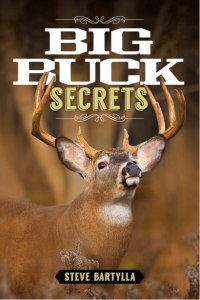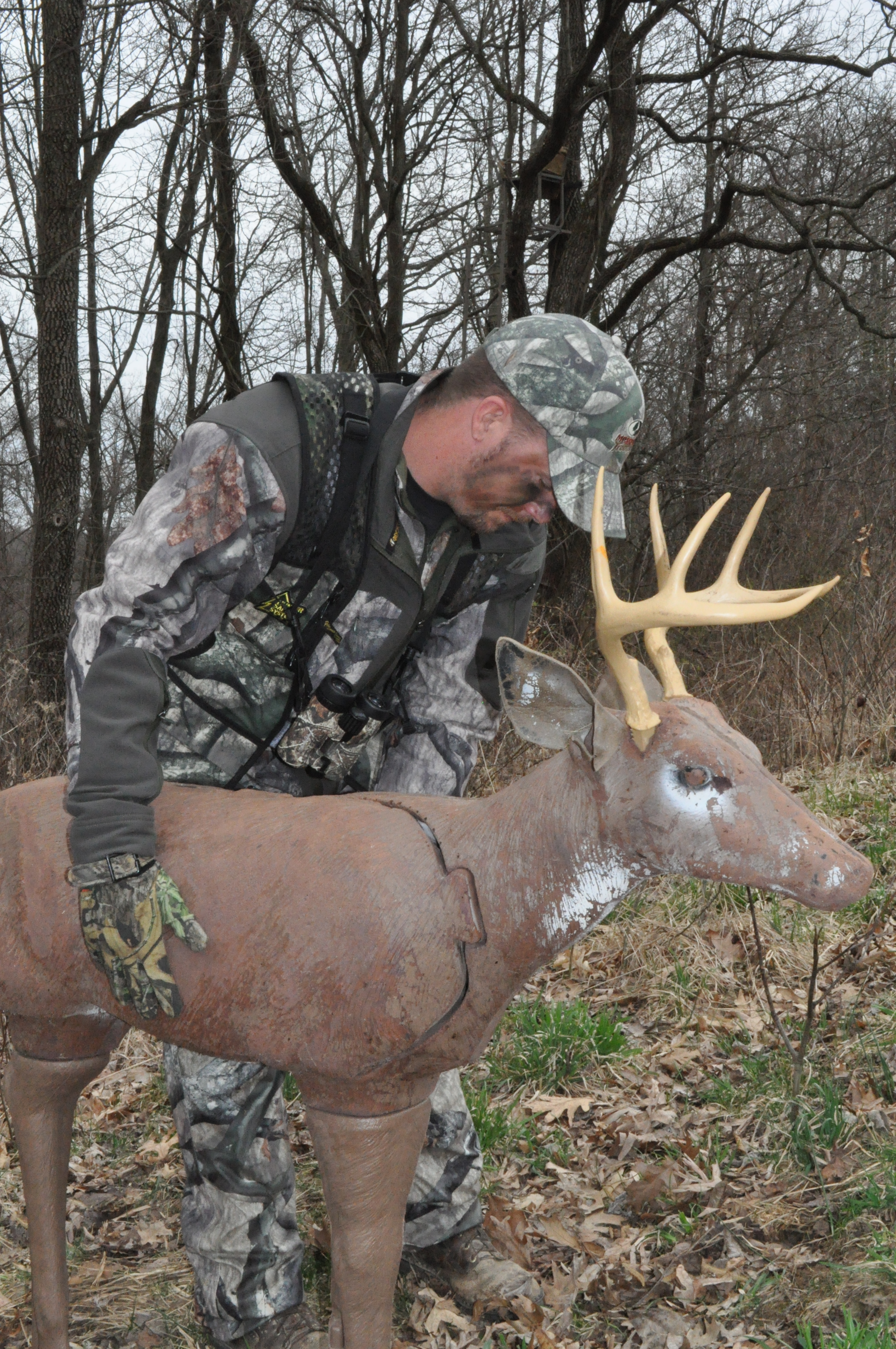
During the pre-rut and rut I love deploying a decoy in my setup and getting aggressive. This seems to be the best time as bucks are on the move, and if they are not with a doe they are usually on edge and ready for a fight at anytime!
The buck decoy I use is posturing with its ears back and the body language suggests this is one mad buck looking for a fight! Some people like to use a doe decoy or a doe and buck combination but I’ve had by far the best luck with just a single postured buck.
I prefer to place my buck decoy about 15-yards from my stand. Also remember that almost all bucks will try and fight your decoy head on. Make sure to position it so you will have a shot when this happens. Now that you’ve decided to try hunting with a decoy, the next step is to continue to fool a mature whitetails senses. I’ve found if you can trick three of their five senses they’ll usually come storming in and never look back.
A whitetail relies heavily on their sense of smell so this is where you need to start and is the most important in my opinion. First ensure you are spraying down your boots and clothes thoroughly with Scent Killer Gold and also think about all your gear as well. If you’re hunting from a ground blind, spray that down. If you’re using a decoy, make sure to spray that down liberally after setting it up in the field. This will keep your own human odor out of the equation.
Hunt Bucks Like Ducks
Duck and goose hunters know the importance of decoys because they focus attention on a specific location and lure the duped birds into range. Savvy whitetail hunters are learning that similar tactics

can work during the rut and the bigger the buck, the harder they fall. Since dominance is a driving force when whitetails are mating, this concept can work across the USA.
For example, George Hopkins operates a deer hunting operation on Maryland’s Eastern Shore that includes a modest 3-D course for bowhunting clients. One morning Hopkins discovered that his range had been vandalized and considered calling the authorities until he noticed that each of his 3-D buck targets had gouge marks. Apparently, a local buck had unleashed it fury on the entire range.
Decoying whitetail deer takes a bit more preparation than waterfowl due to a buck’s keen sense of smell. Mark Sidelinger has taken two P&Y bucks in the past two years in Western Illinois and attributes his success to human scent control. Both bucks were taken at five yards.
“We leave our decoys outside for at least 10 days so that the smells of packaging and shipping dissipate,” Sidelinger said. “Then we wash them down with Scent Killer spray and allow them to “season” another day or two. When we deploy, the decoys, we use latex gloves and spray any areas that may have had human contact.”
The physical size of decoys may discourage their use by archers who also may have a crossbow, tree stand or ground blind to carry. Sidelinger disassembles, covers, and hides his decoys when they are not in use so that when the wind is right, he moves to a stand, assembles the deke and climbs in.
Doe, Buck, or Both?
When considering the decoying tactic, which sex will you need- buck, doe or both? Although there is no perfect answer, take a cue from the wild turkey game. Hen turkeys often don’t like other hens which causes them to shy away.
Similarly, doe decoys may interest bucks, but detour an estrous doe and no buck will leave a hot doe for a prospect. Spring gobblers are driven by dominance, like whitetail deer, and often attack a gobbler decoy throwing caution to the wind.
For similar reason, a modest buck is your best bet and the antler size will depend on the part of the country you hunt and the size of prospective adversaries. A Booner will intimidate an incoming buck while a spike may be ignored.

Placement
Placement is the next important issue. Deploy the decoy for maximum visibility. In the flat country of the Midwest, placing them along a tree line or on a skyline may bring a rutting buck from half a mile. Most times a buck will approach the decoy from downwind so place it about 30 yards upwind of your stand which allows the approaching buck to pass in front of your location.
Have the decoy face you so that the buck doesn’t rush in from behind. Many hunters use rutting scents on the genital area of a decoy (Like Golden Estrous or Golden Buck), yet you don’t want to contaminate it. Sidelinger pins a Scent Killer Key-Wick on the tail area so that he can add estrous scent and freshen it as needed.
Taking the Shot
Decoys work well with deer calling and have a compounding effect. You may call in a deer that won’t come into bow range without seeing another deer. Likewise, rattling, grunting, and doe bleating may lure a buck just close enough to see the decoy and fall for the ruse.
How a buck will react is unpredictable-some come rush in and may literally flatten the decoy in a fit of dominant range. Other times, they will use a stiff-legged approach and may pause to assess its adversary. In every case, you want to be ready to shoot and take the first high-percentage shot. Have your reference points memorized in advance so you can raise your crossbow or draw and release.
Remember Your Scent Control
Much attention has been given to eliminating scent on the decoy, but don’t forget yourself. Just as Sidelinger allows his decoys to “season” for a week or more in the outdoors, he does the same with tree stands and ground blinds. This allows non-native odors to dissipate and local smells to saturate. Once done, he douses his gear with Scent Killer Gold and allows it to dry.
Taking the scent elimination tactic to the max, Sidelinger showers with Scent Killer Gold products but also washes his bed sheets and towels in scent elimination detergents and totally sprays down with Scent Killer before hunting. This may be a step farther than the average hunter is willing to take, yet taking back-to-back P&Y bucks at five yards makes the effort worth every step.
+++++
Learn How to Kill Big Bucks
 Solidly grounded in Bartylla’s wealth of experience, this buck hunting guide seeks to help real-world hunters take their craft to the next level. Chapters in his super book “Big Buck Secrets” include comprehensive instruction on everything from scouting new hunting areas – including public land, to calling strategies, hunting during the rut, understanding mature buck behavior, aggressive and creative techniques, and more – all aimed to help you bag the biggest buck of your life.
Solidly grounded in Bartylla’s wealth of experience, this buck hunting guide seeks to help real-world hunters take their craft to the next level. Chapters in his super book “Big Buck Secrets” include comprehensive instruction on everything from scouting new hunting areas – including public land, to calling strategies, hunting during the rut, understanding mature buck behavior, aggressive and creative techniques, and more – all aimed to help you bag the biggest buck of your life.

